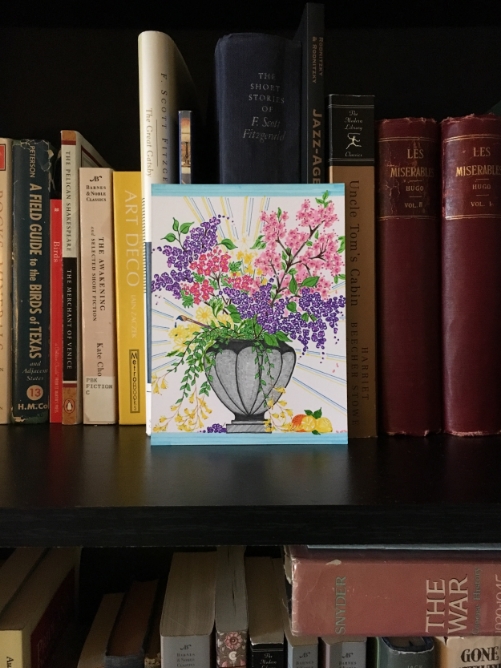I can’t imagine my younger years without trips to the library with my mom. We each had our designated cloth book bags which would be full by the end of our trip; I would stuff mine with Eyewitness books on ancient civilizations, gems, and art, manuals on how to arrange flowers and decorate cakes, tomes on the Titanic, American Girl books, Garfield comic strips, classics such as the Little House series, and of course, Nancy Drew books, their sunny yellow spines lined up one after the other, a bright splash of color on the metal shelves. After school I would read book after book, on my bed, sometimes with a bowl of mint chocolate chip ice cream. Even today it is hard to think of a better way to spend an afternoon.
I could go on and on about each and every book and book series mentioned above, and unmentioned others, too, and I very well may in the future. But in this entry I’ll be focusing on the Nancy Drew series (that is, the 56 classic Nancy Drews, not later iterations of her character in print and media.) Even the author, Carolyn Keene, is mysterious: “Carolyn Keene” was a pseudonym for several authors who wrote, revised, and contributed to the series.
So what is it about Nancy Drew that is so appealing? Perhaps it is the same reason why James Bond was and is so popular from the 1950s to today. You can count on good to conquer evil, the safety of the protagonist no matter what scary situation occurs—overall, a knowledge that everything, and everyone, will be all right. In a sense, we know how each story will end before we start reading it, but that diminishes none of its appeal, it only adds to it. Real life is filled with uncertainties. The fictional River Heights is not.
Another reason for its popularity is obviously the character of Nancy herself. She is courageous, humble, wholesome, and kind. She is talented at a wide range of skills and subjects. She is stylish, attractive, and well-to-do without being snooty. She is prepared for almost any situation that comes her way. In short, she exhibits qualities that are desirable to readers across generations. We know we can’t be exactly like her (she’s a fictional character!), but we can certainly try to succeed at some things. Maybe it is good that she is fictional; that way, she will never change.
Even today, what keeps me going back to the classic Nancy Drew series is the slice of mid-century Americana it offers. Nancy doesn’t “call,” she “phones,” and she’ll even send a telegram. For several years I have been jotting down descriptions of clothing, food, and beverages in the books. The brief descriptions are surprisingly detailed and offer a tantalizing window into a period of American culture that continues to intrigue us (see: Mad Men.) Here are some sartorial highlights: a yellow sunback dress with a jacket and gloves, a pink sports dress, a forest green cotton dress worn with “flat-heeled brown play shoes.” I don’t know what those are, but I want them. I also don’t know where she is living in order to wear a “blue summer sweater suit,” but wherever it is, that’s where I want to be.
And the food! It’s straight out of your mother’s or grandmother’s vintage cookbooks. The Hidden Staircase has some of the best: “luncheons” of chicken salad, biscuits, and fruit gelatin, dinners of steak and French fried potatoes, peas, and floating island, spring lamb and chocolate angel cake. Nancy even goes to a counter in a drugstore and orders split-pea soup and custard pie. Chicken casseroles, bread and butter, milk, hot cocoa, large slices of cinnamon cake with applesauce—these are the foods of period cookbooks that actually include instructions on how to GAIN weight. In The Clue of the Tapping Heels, when Hannah Gruen packs up a “cold supper” of chicken sandwiches, sliced tomatoes, and apple pie with ice cream, it’s all I can do not to climb inside the book, shut the cover on myself, and pray for time travel.
The covers are just wonderful, brightly colored, entertaining to study (the first 34 books have more than one version of the cover art.) On the inside, there are black and white line drawings—a frontispiece and then about five illustrations scattered throughout, always a treat to come across. They themselves are great little time capsules of social history and material culture. In addition, I have learned many vocabulary words and received verifiable knowledge from the books. It may sound incongruous, but it’s very true, I’ve learned a lot from Nancy Drew.
In this design, I wanted to include the two flowers that are mentioned in Nancy Drew titles: lilacs (The Mystery at Lilac Inn) and larkspur (The Password to Larkspur Lane.) Several illustrated covers also include open and lighted windows, such as the earlier covers for The Clue of the Tapping Heels and The Clue of the Velvet Mask, and also The Clue of the Dancing Puppet. For images of these covers, please see below.
















